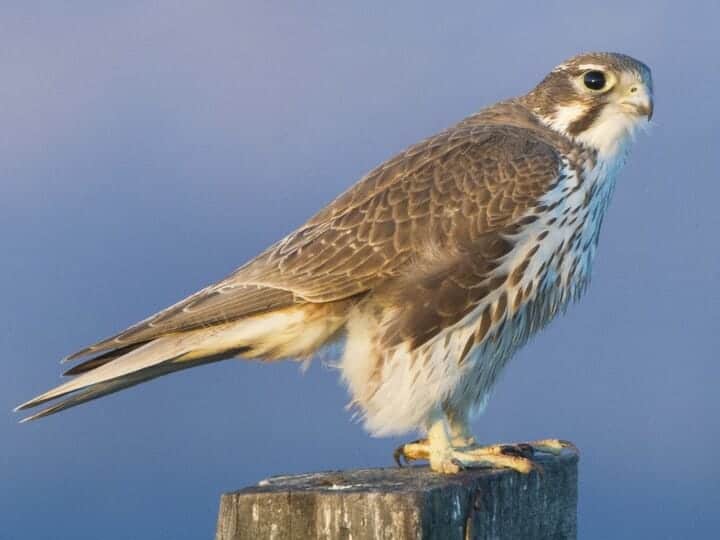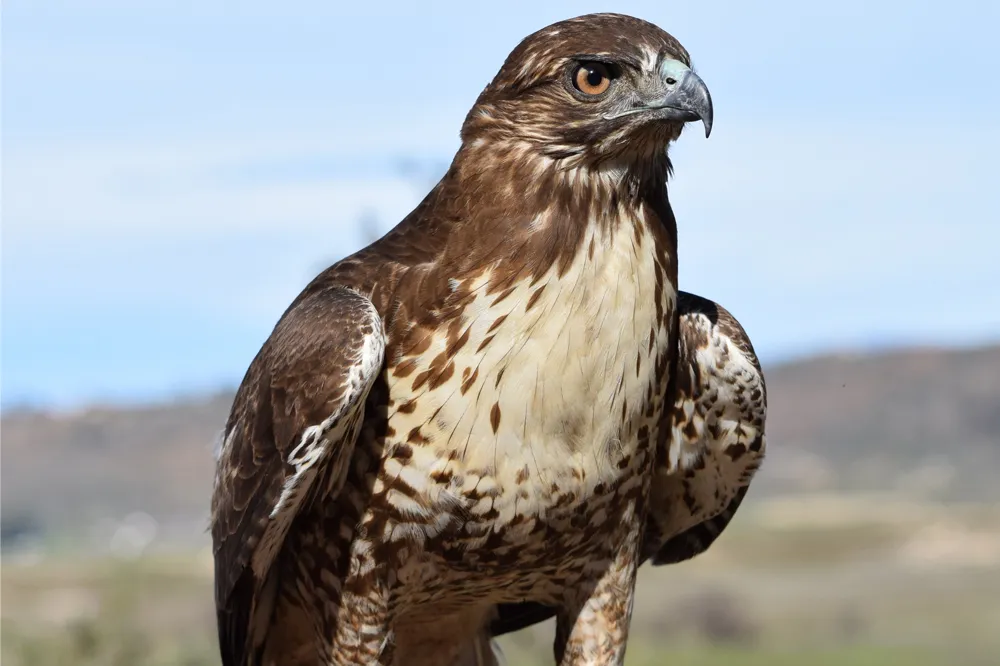Last Updated on: February 4, 2025
Raptors, including hawks, falcons, and eagles, are among the most ferocious birds of prey. The feral wisdom and intense ability of these bird species are fascinating to many birders and falconers around the globe.
However…
Identifying a falcon or hawk is a common identification challenge. While these birders have the skill to distinguish raptors through plumages, it bemuses some amateurs who never had the chance to watch these birds up close.
So, if you’re merely starting your falconry adventure, please read on to help you gain confidence in differentiating hawk vs falcon.
Main Differences Between Falcons And Hawks


The main difference between falcon and hawk are:
- The falcon belongs to the Falconidae family, whereas the hawk is a part of the Accipitridae family.
- The falcon uses its feet and talons when hunting prey, whereas the hawk kills its target with the tooth on its beak.
- The falcon has narrow, tapered wings, whereas the hawk has broader, finger-like wings.
Learning More About The Birds Of Prey Diversity
Bird Classification
Falconiformes are well-known as birds of prey and are primarily diurnal birds, except for the nocturnal owl from the Order Strigiformes.
Falconiformes consist of several families, including the Sagittariidae like the secretary bird, the Pandionidae like the osprey, and the Cathartidae, like the New World vultures.
The Falconidae family features falcons and caracaras, similar to birds in the Accipitridae family, but have notched bills. Additionally, a Falconidae bird has long wings and a reddish-yellow tint inside its eggs.
Falcons came from true falcon taxonomy, Falconiformes order, and Falconidae family, while hawks are from true hawk taxonomy, Accipitriformes order, and Accipitridae family.
The large-sized Accipitridae family has small birds and large birds alike. It includes the red kite, Old World vulture, northern harrier, red tailed hawk, coopers hawk, goshawk, and eagle.
The lineage they belong to is one difference between hawk and falcon, although falcons were formerly relatives of Accipitriformes. Three major falcon groups are the true falcons, like the kestrel, the less-famous forest falcons, and the smallest raptors, the pygmy falcons.
The Accipitridae, one of the suborders of Accipitriformes, are nest builders with prominent broad-fingered wings for soaring and gliding in search of carrion. These birds rely on thermals and updrafts to cover large areas when in flight.
Appearance
Falcons have an anatomical feature adorning the far end of the upper mandible. Such is a helpful feature for a sizable falcon when ripping its prey’s spinal cord. Even its protruding nostril holes that allow air during high-speed flights also come in handy.
Hawks and eagle species use their hooked beaks to rip small mammals apart. Several Accipitridae species have bare necks keeping the blood from dead animals from clogging their feathers.
Unlike the hawk with a slender russet head, a falcon has a short, round grayish-blue head, especially when viewing these birds from a crooked angle.
Accipitrine hawks, such as the sharp-shinned hawk and goshawk, have slim builds and long tails. Generally, falcons have the smallest bird of prey, the pygmy falcon, while the hawks also have the largest raptor, like the ferruginous hawk.
However, size is not a reliable identifier, as there are small hawks as much as small falcons exist.
An expandable crop helps such birds ingest foods in considerable quantities. The transparent membrane of a true hawk and the bone across the brow protect a true hawk during its prey hunt in dense vegetation.
Wings Shape
There is a distinct wing shape for every species, however subtle they might be for some birds. Falconiformes are fast and agile birds; some catch their prey in the air, such as the kestrel, merlin, hobby, and the peregrine falcon.
In both accipiters and falcons, juveniles have wider wings, whereas, in buteos, the wings are narrower in adults.
Even the red-tailed hawk’s rounded wingtips seem tapered when rapidly gliding in flight. In some cases, an adult female Northern Harrier can resemble a young Northern Goshawk.
Whether for prey or flying, diving with wings partially closed allows true hawks to be at their fastest. On the other hand, a falcon’s longwing results in an increased flight speed than a hawk with short rounded wings.
Flight Pattern And Speed
What is the difference between a falcon and a hawk? If you still wonder about this, try looking at how a bird of prey flies to help in better identification.
You can recognize a bald eagle from a golden eagle in flight, even from afar. Unlike bald eagles that lift their wings higher than the horizontal plane when in flight, golden eagles can move their wings consistently up and down.
The true hawks of the Accipitridae can fly at a maximum speed of 62 to 125 mph. Falcons are more adept with the rapid movement of their wings, gliding only for short periods.
The most diminutive falcon in North America, the American kestrel, can excellently flutter midair while going in circles.
Diet
While a bird can take a substantial amount in some hawk species’ diet, it primarily eats small mammals, such as lizards, snakes, rabbits, shrews, and mice. Such a bird of prey as the hawk uses powerful and sharp talons for killing its target.
Some eagles have an affinity for freshwater habitats to prey on sea creatures. The bald eagle, for instance, primarily hunts fishes in the water. The Steller’s sea eagle eats fishes, marine species, or shorebirds.
It’s natural for falcons to feast on flying prey, like a small bird, dragonfly, and bat, compared to a hawk’s more expansive range of food preferences.
By contrast, a falcon does not consume a small bird occasionally, but it comprises a considerable percentage of its main diet. Falcons prefer eating songbirds and even bats for their similarities to birds. In the absence of any small bird the falcon can feast on, it resorts to ground foraging for rodents, reptiles, and amphibians. Smaller-sized falcon species find insects preferable.
While penguins have avian predators, an elephant seal benefits from them the most. If you happen to be into birdwatching raptors, you might notice how a barred-forest falcon has a unique foraging style, following a swarm of army ants.
Hunting Style
Aerial feeding is typical among falcons. A soaring falcon periodically reaches down to feed on large-sized insects. Falcons scan the area for prey by hovering, diving abruptly at prey after spotting it. While a falcon uses its sharp talons for grabbing prey, its beak tears up its meat.
Despite being among the predatory birds, the falcon is a clement predator, hunting in the daytime with its talons while the hawk uses its sharp bill.
In addition to building nests, caracaras are the only ground-foraging falconid; the Peregrine, a sizable falcon, is the fastest creature on earth when plunging for prey. Accipitriformes birds suffocate or bleed out their prey slowly with their feet, devouring them until they die.
Hawks have keen eyesight and can locate their target even 100 meters away. During migration, a sharp-shinned hawk and Cooper’s hawk pause to seize smaller birds and acquire more energy necessary for their travel.
Habitat
Falcons are widespread worldwide, except in Antarctica. These birds of prey display well-adapted behavior toward humans and their environment.
You can encounter falcons in any habitat, including grasslands and deserts, while hawks are mostly in any open grounds in North America, Jamaica, and Central America.
Hawks are adept at any environmental condition and enjoy inhabiting open habitats with shrubberies and nearby trees. You may also see a hawk in urban surroundings.
Nesting And Mating
Male falcons typically pair with larger-sized female falcons. Their courtship rituals start with males bringing prey to the females as they do remarkable acrobatic displays.
Following the mating success, male and female falcons take responsibility for the month-long incubation process. The females choose a nesting ground, utilizing their feet for scraping the ground soil or sand.
Hawks strongly prefer having their nests in high spots, while falcons construct their nests near the ground or using old nests that large birds left behind.
Hawks favor monogamous mating, as with most birds of prey. Such a bird tor stays with a single mate until one of them dies. Part of the hawks’ courtship ritual is seeing male and female hawks soaring in circles in what seems like an acrobatic show at high altitudes.
The hawks like having their nest in high places as they can be immensely territorial. Hawks would not hesitate attacking humans getting too close to their nest, except for the ferruginous hawk. Such a hawk resorts to leaving its nest at even the slightest human disturbance.
Watch This!
Frequently Asked Questions
How can you tell a falcon from a hawk?
The distinguishing features of hawks and falcons are their sizes, beak shapes, wings, hunting styles, and flight patterns. Falcons are from the order of Falconiformes, the genus Falco, like the American kestrel, Peregrine falcon, crested caracara, and more.
Hawks are part of the Accipitridae order or the diurnal birds of prey, including the eagle, kite, and other relatives. Its Accipitrinae or true hawk subfamily is where the sharp shinned hawk belongs.
Which is faster hawk or falcon?
Unlike hawks that only seem to glide in flight, the prairie falcon flies fast enough to chase sea creatures and shorebirds. However, the Peregrine falcon, or Falco peregrinus, is well-known as the fastest bird globally. Contrastingly, the red tailed hawk has a slow, steady flight.
Falcon vs hawk who would win?
Almost every bird has distinct strengths and weaknesses. Even with other species, such competition exists among the most powerful creatures. Hence, books like the Ultimate Shark Rumble and Ultimate Dinosaur Rumble became famous to curious animal enthusiasts.
However, in a head-on battle, the hawk has more chances to win if this bird species uses sheer strength. Fighting on the ground gives the sizable hawk an edge. But the falcon’s exceptional speed and maneuverability likewise mean better chances in an aerial battle.
Conclusion
Observing interesting facts about raptors’ behavior, hunting style, and flight pattern can help us identify the difference between a hawk and a falcon.
Understanding different species of birds of prey allows us to find distinguishing features better. Species identification comes with various challenges, especially with overlapping characteristics like in the confusion regarding falcons vs hawks.
Seasoned falconers or hawk watchers can be exceptional in hawk vs falcon identification. But it brings into play the familiarity that comes with their experience of these predatory species.
Continue watching, take exhaustive field notes on the spot, and never stop learning about these raptors. Today, many birds face various threats, making it crucial to understand, appreciate, and protect the birds we see around us every day.

